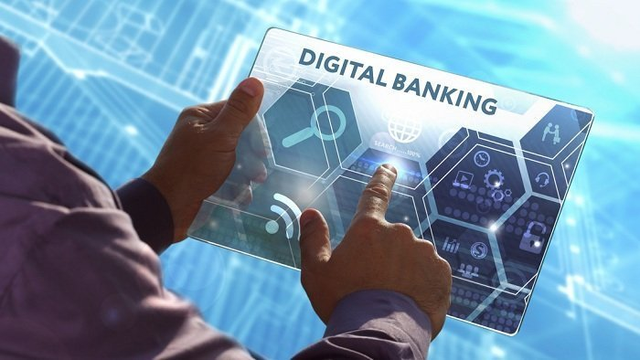History of Banking
- The history of banking began with the first prototype banks, that is, the merchants of the world, who gave grain loans to farmers and traders who carried goods between cities. This was around 2000 BCE in Assyria, India, and Sumeria.
- Later, in ancient Greece and during the Roman Empire, lenders based in temples gave loans while accepting deposits and performing the change of money. Archaeology from this period in ancient China and India also shows evidence of money lending.
- The Bardi and Peruzzi families dominated banking in 14th-century Florence, establishing branches in other parts of Europe.
- The oldest bank still in existence is Banca Monte dei Paschi di Siena, headquartered in Siena, Italy, which has been operating continuously since 1472.
Digital transformation & Fintech has revolutionized the traditional banking industry.
It involves integrating digital technology into various aspects of banking, from customer service to back-end operations. The goal is to make banking more efficient, convenient, and accessible to customers.
It is changing the way banks do business in several ways.
- Changing the way customers interact with their banks. Online and mobile banking are becoming more prevalent, allowing customers to access their accounts and conduct transactions from anywhere at any time.
- Digital transformation is changing the way banks operate. Automation and artificial intelligence are being used to streamline back-end operations and reduce costs. This allows banks to offer better products and services at lower prices.
- Finally, digital transformation & Fintech Companies are changing the competitive landscape in banking. New entrants, such as fintech companies and digital banks, are challenging traditional banks by offering innovative products and services that are more in tune with the needs of modern consumers.
How are Digital Banks & Fintech companies challenging the incumbents in the value chain?
- Increased competition: Digital Banks &Fintech companies are challenging traditional banks by offering innovative and convenient financial products and services that often have lower fees and better user experiences. As a result, traditional banks are under pressure to adapt and innovate to remain competitive.
- Improved customer experience: Digital Banks &Fintech companies leverage technology to create seamless and user-friendly customer experiences. This includes offering 24/7 access to financial services, faster and more efficient processes, and personalized recommendations based on data analysis.
- Greater financial inclusion: Digital Banks &Fintech companies are helping to expand access to financial services for underbanked and underserved populations. For example, P2P lending platforms credit individuals and small businesses who may have difficulty accessing traditional bank loans.
- Increased efficiency: Digital Banks &Fintech companies are automating many financial processes, which can lead to increased efficiency and cost savings for both consumers and businesses.
Types of Digital Banks
- Challenger banks: These digital-only banks challenge traditional banks by offering a more innovative and customer-friendly banking experience. Examples include Monzo, N26, and Revolut.
- Neo banks: These are online-only banks that use technology to provide faster and more efficient banking services. Examples include Ally Bank, Simple, and Chime.
- Traditional banks with digital offerings: These are conventional banks incorporating digital services and features to compete with digital-only banks. Examples include Chase Bank and Bank of America.
- Fintech companies: These are technology companies that offer financial services such as payments, lending, and investing. Examples include PayPal, Apple pay, Square, and Robinhood.
What are the key trends shaping the future of banking, such as the use of AI, blockchain, and open banking?
- Artificial Intelligence (AI): Banks increasingly use AI to improve customer experience and automate internal processes. AI-powered chatbots and virtual assistants are used to handle customer queries, while machine learning algorithms are used to detect fraud and assess credit risk.
- Blockchain: The distributed ledger technology behind cryptocurrencies is being explored by banks for various applications, such as reducing transaction costs, improving security, and streamlining payment processes.
- Open Banking: Open banking regulations have been introduced in many countries, which require banks to share customer data with third-party providers. This has led to the emergence of new fintech companies and innovative services, such as account aggregation and payment initiation.
- Digital Transformation: Banks are undergoing a digital transformation to stay competitive and meet changing customer expectations. This includes adopting mobile banking, online banking, and digital payments.
- Fintech: Short form of financial technology that refers to the use of technology to improve and automate financial services. Fintech is disrupting the traditional banking industry by offering innovative solutions that meet consumers’ changing demands and expectations.
- Personalization: Banks increasingly use customer data to provide personalized products and services. This includes tailored investment advice, personalized offers, and customized financial planning.
Overall, these trends are shaping the future of banking and will continue to do so in the coming years. Some examples include mobile banking, online lending, digital wallets, robo-advisors, peer-to-peer (P2P) payments, and blockchain-based solutions. Moreover, adopting digital innovations such as smart chips, biometric sensors, branchless banking, artificial intelligence, and machine learning to protect against fraud and a better customer experience.
What are digital banking channels? And how is digital banking using the web?
The key digital banking channels are:
- Online banking: This channel allows customers to access their bank accounts, transfer funds, pay bills, and view transaction history through a website. To thrive in the digital world, it is important for banks to reimagine online banking. The NextGen internet banking solutions offer convenience and control so that bank’s customers can manage their personal finances on the go. From a well-thought-out user experience and AI-enabled quick payments to simplified, agony-free tasks such as raising disputes, payment instructions, etc. Moreover, e-banking solutions enable banks to engage proactively with their customers while ensuring robust data security.
- Mobile banking: This channel enables customers to perform banking transactions using smartphones or tablets through a mobile application. The pool of smartphone users is growing extensively, and staying ahead of this digital disruption is essential. Digital banks accelerate their mobile banking services for customers by personalizing their experience and integrating an advanced user interface. Some specialized mobile banking solutions include PFM and AI-based platforms to create unique offerings.
- Wearable Banking: WYOD (Wear Your Own Device) and wearable banking services are trending around the globe. The customers access banking solutions on the move by focusing on prime features to track various banking activities like—alerts and notifications on payments, balance inquiries, promotional bank offers, and quick reports on the account balance. This channel enables your customers to submit requests, transfer funds, make payments and more with a simple touch or voice command.
- Chatbot Banking: AI chatbots are driving digital capabilities to make conversational banking more mainstream. Banks must integrate this medium and enable a conversational banking solution to create a two-way digital customer experience. The banking chatbot can become a bank’s customer’s personal financial concierge by answering routine queries and FAQs. The chatbots also help customers make smarter financial decisions, manage cash flow, track spending habits, and plan their savings.
What are the challenges that banks of the future may face?
- Cybersecurity Threats: With the rise of digitalization, banks have become more vulnerable to cyber-attacks. As cybercriminals continue to develop sophisticated hacking techniques, banks must invest heavily in cybersecurity to protect themselves and their customers. This will require continuous updates to security protocols, investment in employee training and awareness, and implementation of advanced security measures such as biometric authentication, firewalls, and intrusion detection systems.
- Changing Consumer Behaviors: Consumer behaviors have been changing rapidly with the advent of mobile and online banking. This has led to increased digital transactions and demand for convenient, fast, and secure payment systems. Banks must adapt to these changing behaviors by investing in new technologies, such as mobile payment systems, digital wallets, and artificial intelligence, and offering more personalized services to meet customers’ needs.
- Regulatory Compliance: Banks are subject to a growing number of regulatory requirements, such as the General Data Protection Regulation (GDPR) and the Payment Services Directive 2 (PSD2). Compliance with these regulations can be expensive, and non-compliance can result in significant penalties. Banks must invest in compliance systems and processes to ensure they meet regulatory requirements and protect their customers’ data.
- Legacy IT Systems: Many banks still use legacy IT systems, which can be challenging to update and maintain. These systems can pose a significant security risk, as they are often more vulnerable to cyber-attacks. Banks must modernize their IT systems and invest in new technologies to improve their security posture and meet the changing needs of their customers.
- Third-party Risks: Banks often work with third-party vendors and partners to provide services to their customers. These third-party vendors can pose a significant security risk if they are not properly vetted and managed. Banks must invest in processes and tools to manage third-party risks and ensure their partners follow proper security protocols.
Overall, the banking industry will likely face significant disruption as customer expectations evolve. Banks that can adapt and innovate to meet these changing demands are likely to thrive, while those that fail to do so may struggle to compete.




